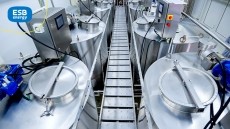Visionary thinking

Managers accustomed to hearing marketing-inspired talk about 'next generation' equipment, whatever the function, are equally used to asking: 'What's wrong with the existing generation?'
When it comes to product inspection and quality control, vision systems provide a neat example of just how that 'next generation' question can play out in practice.
At Lincoln University, Dr Tom Duckett of the School of Computer Science is working on a 'trainable vision' project part-funded by the Technology Strategy Board, running up to October 2015. Lead research and development (R&D) partner is Ishida Europe, with local potato and produce processor Branston also involved in factory trials and evaluation.
IT and projects director at Branston Vidyanath Gururajan explains: "We've got three different vision grading systems from different suppliers in our factory, and they all do their jobs. But we're looking at the next generation."
So just what are they looking at? "Currently, it requires someone who can reprogramme the database to add new items," he says. "We're looking for something which is more user-friendly ̶ more factory-friendly."
As with other evolving technologies such as robotics, a part of the barrier for potential new users consists of perceptions about cost and return on investment (ROI), complexity, maintenance requirements and so on.
The attraction of much high-tech equipment lies in its reliability and flexibility. But, as Gururajan states, customers do not want that flexibility to come at the cost of time-consuming and possibly expensive reprogramming.
"Every vision system has its own application, but what is particularly interesting for us is the 'trainability' aspect," he says.
"Lincoln University's idea is that you should be able to 'educate' the system, by running a product through several times, to recognise that product and to spot any defects. So, for example, if you have potatoes with herbs in the pack, the system will recognise the packaging and the product inside. It will detect any items that shouldn't be in the pack or, for instance, the wrong type of packaging."
Lincoln's Duckett explains: "The current generation of equipment is rather limited by its specificity. When you buy a system, it is customised to a particular application, with an imaging sensor and lighting that are specific to that application. "
His aim, he says, is to develop a system that can work on different inspection functions with a single type of lighting and that can be more easily set up by members of the in-house quality control team.
In the context of Branston's factory, for instance, could a system be 'trainable' to detect not only greening on a white potato variety, but also on a red variety, where the same defect would appear as a blackening?
Sorting systems supplier Tomra, which now owns the Best range of inspection equipment, says it is working on exactly this type of accessibility. UK agent Nicolas Stein explains: "Currently, the basic settings and thresholds are already set. But as part of our basic training, individuals can be instructed in how to modify thresholds, for instance. They have to be comfortable with that, and I'm not saying that all of our customers will be good at it."
He adds: "We're also working on integrating automatic training capabilities into all of our systems. The current technique for programming the machine does require some level of knowledge. You have to create certain combinations of signals, and know what you're looking for."
As he emphasises, while the basic programming can be relatively quick, you want thresholds as low as possible. "You don't want to reject 25% of your product," he says. "And that fine-tuning can take a matter of hours."
According to Stein, the new Smart Sort capability will dramatically reduce set-up times. "You will be able to run, say, 10 kilos of product and the machine will automatically put thresholds in place for you," he says. Some sort of optimisation will still be necessary. "That would again require some knowledge of the system, but anyone comfortable with computers should be able to carry this out."
For others, this next-generation user-friendliness is already available. At Cognex, senior sales engineer Stephen Makepeace-Warne says: "Our systems are configurable, so if you know you're going to be adding new variants or varieties, you can train them in. Grading apples, for instance, you can train a colour model covering the range of shades. As with packaging, you have a base job, but the end-user can save a new label, for example, or new colour model."
It does appear, though, that different manufacturers attach varying amounts of importance to this question of accessibility and 'trainability'. At Mettler Toledo, for instance, head of marketing and product management at group company Pharmacontrol Electronic Marcus Pabsch says: "Our systems are quite flexible, and parameters can be adjusted by the customers themselves."
So far, so good. But he adds: "Some algorithms can be used to retrain the system. You may need a vision expert, someone who knows about light and image processing, but not necessarily someone from the supplier or integrator."
In many factories, tracking down that expert on light and vision processing could be a tall order, without special training.
When it comes to cost, most suppliers agree that the price tag on a mid-range vision system has remained fairly constant over the last few years. "It's been quite stable," says Pabsch. "And the systems available for a given price are performing better. So where you might have got one megapixel resolution a few years ago, you could have 20 megapixels now."
At Tomra, Stein draws a comparison with trends in consumer PCs and laptops. "Prices have been very static," he agrees. "But, as with a computer, you'll get a much better piece of equipment for the same price you would have paid five or six years ago."
There are also low-cost options with reduced functionality. So, for example, Cognex has introduced its In-Sight 7000 series of colour vision systems, including the entry-level 7010C which, in a food and drink context, could be used to confirm a match between product flavour or colour and packaging. Other models can be used in more complex colour-based applications, or where higher speeds or resolution are required.
According to Makepeace-Warne, this type of entry-level application from Cognex might also include checking for the presence (but not content) of best before dates, for example. But beyond this basic level, he too has seen fairly flat capital costs for vision systems over the past five years or so. "But then, if you go back further to around 10 years ago, the price has effectively halved," he adds.
More recently, like Pabsch at Mettler Toledo, he has seen the specifications available for that same price improve dramatically.
"If you go back 10 years or so, vision systems weren't very robust," says Makepeace-Warne. "They were affected by changes in ambient lighting, and often triggered a lot of false rejects. New algorithms introduced about six years ago have been able to cope much better with lighting variations, changes in background, scale change and rotation. They can also function even when the lens is slightly defocused."
Functionality, memory and speed have increased, while size has decreased. Cognex has one camera and computer which together fit inside a 30mm x 30mm x 60mm box, he says, with a single cable doubling as Ethernet and power input.
As for food industry perceptions of cost versus benefits and ROI, those too are changing, and for an equally wide variety of reasons. "A major consideration is the cost of returns from supermarkets, even for very minor errors," says Makepeace-Warne. "It could be something as small as a missing flash label." Paying to destock and restock can be a major blow, but for perishable product, that may mean writing off an entire shipment.
"You can go into customers' premises today that have started to see £100,000 or £200,000 fines from retailers, and to stop that they simply need to invest in a £10,000 or £15,000 vision system," he says.
As Cognex explains, the problem of false rejects is largely in the past, and processors such as Branston do not see this as a major issue.
At the same time, the improved processing power and speed of vision systems means that multiple inspections at a single point on the line are more achievable. As Branston's Gururajan explains, seal integrity checking is likely to be a part of this: "Being able to check seal quality with an online system is a huge advantage. With the length of production and packaging lines always increasing, being able to combine two or three checks in a single compact system would be even better."
Various carrots and sticks are luring and prodding manufacturers towards greater acceptance of vision as a cost-effective, multi-tasking inspection system. With all carrots conforming to strict colour, shape and defect-free parameters, who can blame these companies for being tempted?

















